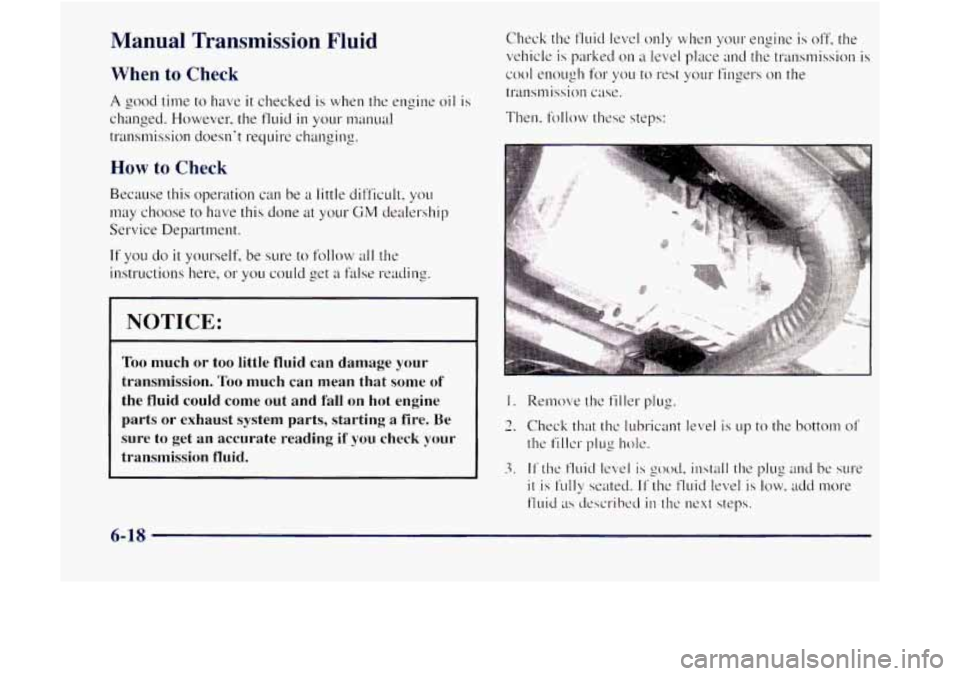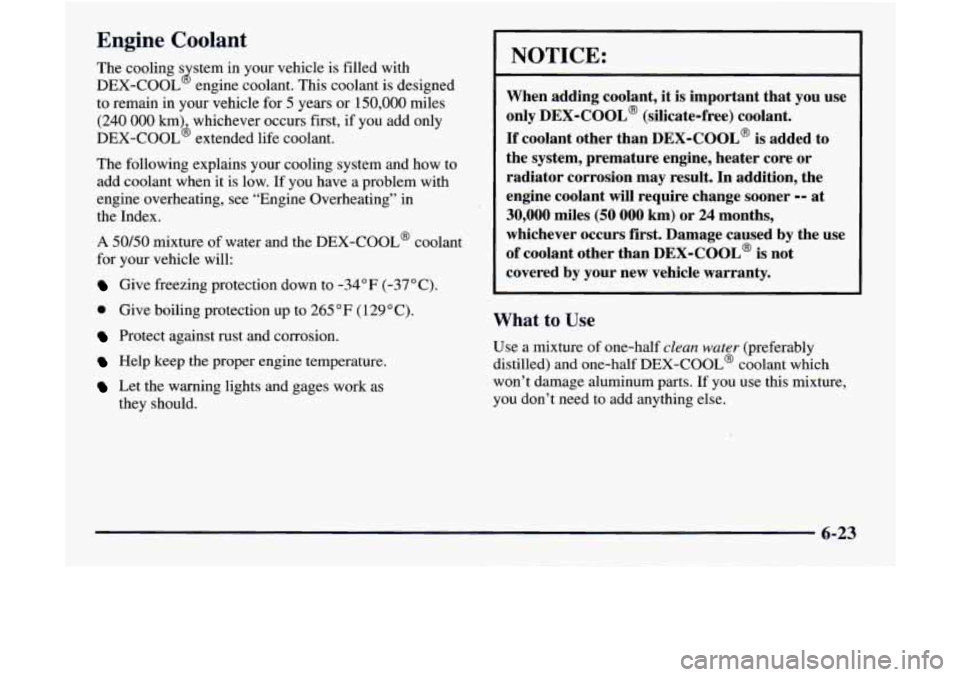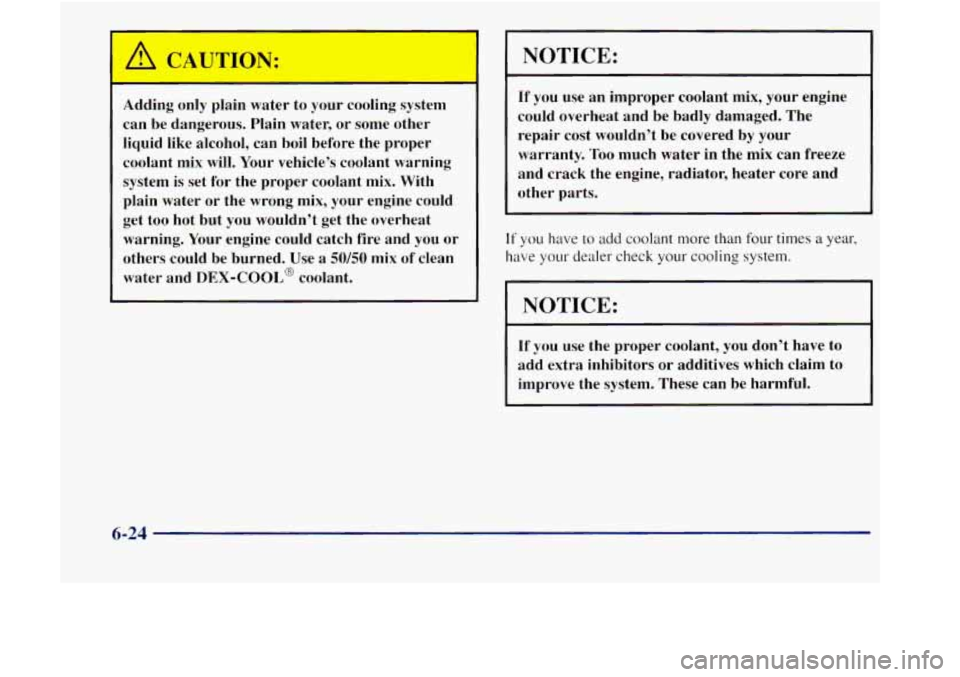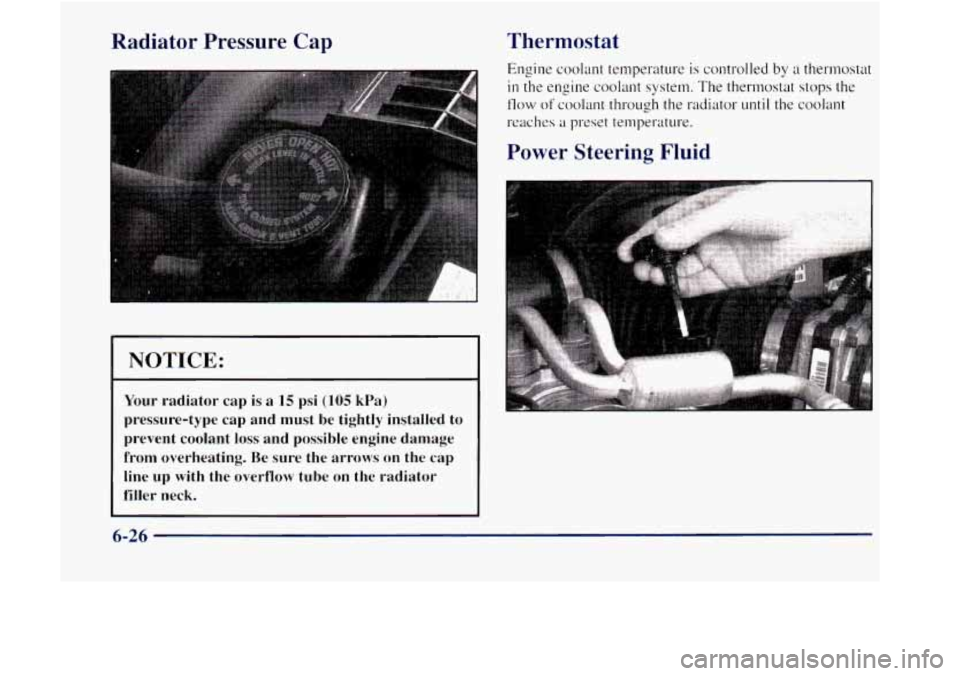engine GMC JIMMY 1997 Manual PDF
[x] Cancel search | Manufacturer: GMC, Model Year: 1997, Model line: JIMMY, Model: GMC JIMMY 1997Pages: 410, PDF Size: 20.03 MB
Page 277 of 410

Manual Transmission Fluid
When to Check
A good time to have it checked is when the engine oil is
changed. However, the fluid in YOLK manual
transmission doesn't require changing.
How to Check
Because this operation can be a little dii'licult, you
may choose to have this done at your GM dealership
Service Department.
If you do it yourself, be sure to follow all the
instructions here, or you could get
false reading.
NOTICE:
Too much or too little fluid can damage your
transmission.
Too much can mean that some of
the fluid could come out and fall on hot engine
parts or exhaust system parts, starting a
fire. Be
~ sure to get an accurate reading if you check your
~ transmission fluid.
6-18
Page 282 of 410

Engine Coolant
The cooling s stem in your vehicle is filled with
DEX-COOL engine coolant. This coolant is designed
to remain in your vehicle
for 5 years or 150,000 miles
(240 000 km) whichever occurs first, if you add only
DEX-COOL’ extended life coolant.
The following explains your cooling system and how to
add coolant when it is low. If you have a problem with
engine overheating, see “Engine Overheating” in
the Index.
A 50/50 mixture of water and the DEX-COOL@ coolant
for your vehicle will:
Give freezing protection down to -34°F (-37°C).
0 Give boiling protection up to 265 OF ( 129 O C).
Protect against rust and corrosion.
Help keep the proper engine temperature.
Let the warning lights and gages work as
8
they should.
NOTICE:
When .adding coolant, it is important that you use
only
DEX-COOL@ (silicate-free) coolant.
If coolant other than DEX-COOL@ is added to
the system, premature engine, heater core
or
radiator corrosion may result. In addition, the
engine coolant will require change sooner
-- at
30,000 miles (50 000 km) or 24 months,
whichever occurs
first. Damage caused by the use
of coolant other than DEX-COOL@ is not
covered by your new vehicle warranty.
What to Use
Use a mixture of one-half clean water (preferably
distilled) and one-half DEX-COOL@ coolant which
won’t damage aluminum parts. If you use this mixture,
you don’t need to add anything else.
6-23
Page 283 of 410

Adding only plain water to your cooling system can be dangerous. Plain water, or some other
liquid like alcohol, can boil before the proper
coolant mix will. Your vehicle’s coolant warning
system
is set for the proper coolant mix. With
plain water or the wrong mix, your engine could
get too hot but you wouldn’t get the overheat warning. Your engine could catch fire and you or
others could be burned. Use a
50/50 mix of clean
water and
DEX-COOL@ coolant.
NOTICE:
If you use an improper coolant mix, your engine
could overheat and be badly damaged. The
repair cost wouldn’t be covered by your
warranty.
Too much water in the mix can freeze
and crack the engine, radiator, heater core and
other parts.
If you have to add coolant more than four times a year,
have your dealer check your cooling
system.
I NOTICE:
If you use the proper coolant, you don’t have to
add extra inhibitors or additives which claim to improve the system. These can be harmful.
6-24
Page 284 of 410

Checking Coolant
When your engine is cold. the coolant level should be at
ADD, or a little higher. When your engine is warm. the
level
should be up to FULL HOT, or a little higher.
Adding Coolant
If you need more coolant, add the proper DEX-COOL'
coolant mixture crt rhe cwolcrllt I-KO\!PI-J tcrnk.
~ ' Turning the radiator pressure cap when the
engine and radiator are hot can allow steam and
scalding liquids to blow out and burn
you badly.
With the coolant recovery tank,
you will almost
never have to add coolant at the radiator.
Never turn the radiator pressure cap
-- even a
little
-- when the engine and radiator are hot.
Add DEX-COOL@ coolant mixture at the recovery
tank, but be careful not to spill
it.
You can be burned if you spill coolant on hot
engine parts. Coolant contains ethylene glycol,
and it will burn
if the engine parts are hot
enough. Don't
spill coolant on a hot engine.
6-25
Page 285 of 410

Radiator Pressure Cap
NOTICE:
Your radiator cap is a 15 psi (105 kPa)
pressure-type cap and must be tightly installed to
prevent coolant
loss and possible engine damage
fronl overheating. Be sure the arrows
on the cap
line up with the overflow tube on the radiator
filler neck.
Thermostat
Engine coolant temperattrre is controlled by a thermostat
in the engine coolant system. The thermostat stops the
flow of coolant through the radiator until the coolant
reaches
a preset temperature.
Power Steerinp Fluid
6-26
Page 286 of 410

When to Check Power Steering Fluid
It is not necessary to regularly check power steering
fluid ~rnless
you suspect there is a leak in the system or
you hear an unusual noise. A fluid loss in this system
could indicate
a problem. Have the system inspected
and repaired.
How To Check Power Steering Fluid
When the engine compartment is cool, wipe the cap and
the top of the reservoir clean, then unscrew the cap and
wipe
the dipstick with a clean rag. Replace the cap and
completely tighten
it. Then remove the cap again and
look at the fluid level on the dipstick.
The level should be between the
ADD and FULL marks.
If necessary, add only enough fluid to bring the level up
to the proper range.
What to Use
Windshield Washer Fluid
What to Use
When you need windshield washer fluid. be sure to read
the manuf‘~cturer’s instructions before ~rse.
If you will be
operating your
\:chicle in an area where the temperature
may fall below freezing,
LIS~ a fluid that has sufficient
protection against freezing.
Adding Washer Fluid
To determine what kind of fluid to use, see
“Recommended Fluids and Lubricants”
in the Index.
Always use the proper fluid. Failure to use the proper
fluid can cause leaks and damage hoses and seals.
Open
the cap labeled WASHER FLUID ONLY with the
washer symbol 011 it. Add washer tluid until the tank is full.
6-27
Page 288 of 410

There are only two reasons why the brake fluid level in
the reservoir might go down. The first is that the brake
fluid goes down to an acceptable level during normal
brake lining wear. When new linings are put in, the fluid
level goes back up. The other reason is that fluid is
leaking out of the brake system. If it is, you should have
your brake system fixed, since a leak means that sooner
or later your brakes won’t work well, or won’t work
at all.
So, it isn’t a good idea to “top off’ your brake fluid.
Adding brake fluid won’t correct a leak. If you add fluid
when your linings
are worn, then you’ll have too much
fluid when you get new brake linings. You should add
(or remove) brake fluid, as necessary, only when work is
done on the brake hydraulic system. Refer
to the Maintenance Schedule to determine when to
check your brake fluid. See “Periodic Maintenance
Inspections” in the Index.
Checking Brake Fluid
If you have too much brake fluid, it can spill on the
engine. The fluid
wiu burn if the engine is hot
enough.
You or others could be burned, and your
vehicle could
be damaged. Add brake fluid only
when work
is done on the brake hydraulic system.
I
You can check the brake fluid without taking off the cap.
Just look at the windows on the brake fluid reservoir. The fluid levels should be above MIN. If they aren’t,
have your brake system checked to see
if there is a leak.
After work is done on the brake hydraulic system, make
sure the levels are above
MIN and below the top of
each window.
6-29
Page 289 of 410

What to Add
When you
do need brake fluid, use only DOT-3 brake
fluid
-- such as Delco Supreme 1 l@ (GM Part
No. 12377967). Use new brake fluid from a sealed
container only.
Always clean the brake fluid reservoir
cap and the area
around the
cap before removing it. This will help keep
dirt from entering the reservoir.
I
With the wrong kind of fluid in your brake
system, your brakes may not work well, or they
may not even work
at all. This could cause a
crash. Always use the proper brake fluid.
NOTICE:
Using the wrong fluid can badly damage
brake system parts. For example, just
a few
drops
of mineral-based oil, such as engine
oil, in your brake system can damage brake
system parts
so badly that they’ll have to be
replaced. Don’t let someone put
in the
wrong kind of fluid.
0 If you spill brake fluid on your vehicle’s
painted surfaces, the paint finish
can be
damaged. Be careful not to spill brake fluid
on your vehicle. If you do, wash it off
immediately. See “Appearance Care” in
the Index.
6-30
Page 292 of 410

Vehicle Storage
If you’re not going to drive your vehicle for 25 days or
more, take off the black, negative (-) cable from the battely.
This will help keep your battery from running down.
Bulb Replacement
Before you replace any bulbs, be sure that all the lamps
are
off and the engine isn’t running. See “Replacement
Bulbs‘‘
in the Index.
,/i Cfi JTION:
Batteries have acid that can burn you and gas
that can explode.
You can be badly hurt if you
aren’t careful. See “Jump Starting” in the Index
for tips on working around a battery without
getting hurt.
Contact your dealer to learn how to prepare your vehicle
for longer storage periods.
Also, for your audio system. see ”Theft-Deterrent
Feature”
in the Index.
Halogen Bulbs
A CAU ION:
Halogen bulbs have pressurized gas inside and
can burst if
you drop or scratch the bulb. You or
others could be injured. Be sure to read and
follow the instructions
on the bulb package.
6-33
Page 317 of 410

Vehicle Identification Number (VIN)
m I11111111 1111 111 111111 111 111111 I1 111111111111 111111111 II, 0
I d SAMPLE4UXVM072675
I ENGINEb7 f ASSEMBLY I
CODE MODEL YEAR PLANT ~~
This is the legal identifier for your vehicle. It appears on
a plate in the front corner of the instrument panel, on the
driver's side. You can see
it if you look through the
windshield from outside your vehicle. The
VIN also
appears on the Vehicle Certification and Service Parts
labels and the certificates of title and registration,
Engine Identification
The 8th character in your VIN is the engine code. This
code
will help you identify your engine, specifications
and replacement parts.
Service Parts Identification Label
You'll find this label on the inside of the glove box. It's
very helpful if you ever need to order parts. On this
label is:
your VIN,
the model designation.
paint information and
a list of all production options and special equipment.
Be sure that this label is not removed from the vehicle,
Electrical System
Add-on Electrical Equipment
NOTICE:
Don't add anything electrical to your vehicle unless
you check with your dealer first. Some electrical
equipment can damage your vehicle and the
damage wouldn't be covered by your warranty.
Some add-on electrical equipment can keep other
components from working
as they should.
Your vehicle has an air bag system. Before attempting to
add anything electrical to your vehicle, see "Servicing
Your Air Bag-Equipped Vehicle" in the Index.
6-58